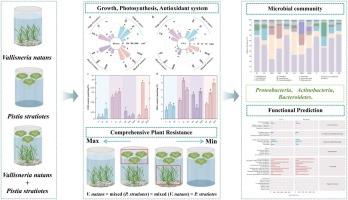Comparative study of the toxicity responses of Vallisneria natans and Pistia stratiotes to sulfadiazine under different planting methods
IF 12.2
1区 环境科学与生态学
Q1 ENGINEERING, ENVIRONMENTAL
引用次数: 0
Abstract
Sulfonamides are receiving increased attention due to their persistence in the environment and potential ecological risks. However, there are currently relatively few studies on the toxicity response of aquatic plants grown under the single and mixed planting methods to sulfadiazine (SD). This study investigated the response of the Vallisneria natans (Lour.) Hara (V. natans) and the Pistia stratiotes L. (P. stratiotes) to SD toxicity under single and mixed planting methods. The findings demonstrated that under the mixed planting method, 0.3 μg/L SD significantly reduced the biomass of V. natans (p < 0.05) while increasing the biomass of P. stratiotes. Under the single planting method, the chlorophyll a content of V. natans and P. stratiotes showed the highest value when exposed to 0.3 μg/L SD. The chlorophyll b content of V. natans and P. stratiotes was higher in the single planting method compared to mixed planting method. In single planting, V. natans exhibited the highest superoxide dismutase (SOD) activity when exposed to high concentrations of SD (3.0 μg/L). However, under the mixed planting method, the SOD activity of V. natans and P. stratiotes reduced at 0.3 μg/L SD. P. stratiotes showed increased malondialdehyde (MDA) and glutathione S-transferase (GST) activities at 3.0 μg/L SD under the single planting method. The comprehensive stress resistance ranking was as follows: single planting (V. natans) > mixed planting (P. stratiotes) > mixed planting (V. natans) > single planting (P. stratiotes). Moreover, exposure to SD downregulated the cell motility metabolic pathway of V. natans and P. stratiotes, particularly under the mixed planting method, to increase the resistance of V. natans and P. stratiotes to SD exposure. Proteobacteria, Actinobacteria and Bacteroidetes were the dominant phyla. This study provides basic data and scientific support for the selection of plants for remediation of higher SD polluted waters using ecological remediation.

不同种植方式下黑尾草和层状豆对磺胺嘧啶毒性反应的比较研究
磺胺类由于其在环境中的持久性和潜在的生态风险而受到越来越多的关注。然而,目前关于单一种植和混合种植方式下水生植物对磺胺嘧啶(SD)毒性反应的研究相对较少。本研究考察了水草(Vallisneria natans, Lour.)单种和混种方式下,野田原(V. natans)和大薸(P. stratiotes L.)对SD的毒性。结果表明:在混作方式下,0.3 μg/L的SD显著降低了紫菀的生物量(p <;0.05),而增加了层状叶青的生物量。在单株种植条件下,当SD浓度为0.3 μg/L时,水曲柳和地层树的叶绿素a含量最高。单作方式下,水草和层迭草的叶绿素b含量高于混作方式。单株栽培中,当SD浓度达到3.0 μg/L时,紫花苜蓿超氧化物歧化酶(SOD)活性最高。而在混作方式下,0.3 μg/L SD下,水草和地层树的SOD活性降低。3.0 μg/L SD单株栽培条件下,大叶茅丙二醛(MDA)和谷胱甘肽s转移酶(GST)活性明显升高。综合抗逆性排序为:单株(V. natans) >;混合种植(P. stratiotes)混合种植(V. natans) >;单株(层状木)。此外,在SD照射下,特别是混合种植方式下,紫花苜蓿和层迭草的细胞运动代谢途径下调,从而增加了紫花苜蓿和层迭草对SD照射的抗性。变形菌门、放线菌门和拟杆菌门为优势门。本研究为生态修复高SD污染水体的植物选择提供了基础数据和科学支持。
本文章由计算机程序翻译,如有差异,请以英文原文为准。
求助全文
约1分钟内获得全文
求助全文
来源期刊

Journal of Hazardous Materials
工程技术-工程:环境
CiteScore
25.40
自引率
5.90%
发文量
3059
审稿时长
58 days
期刊介绍:
The Journal of Hazardous Materials serves as a global platform for promoting cutting-edge research in the field of Environmental Science and Engineering. Our publication features a wide range of articles, including full-length research papers, review articles, and perspectives, with the aim of enhancing our understanding of the dangers and risks associated with various materials concerning public health and the environment. It is important to note that the term "environmental contaminants" refers specifically to substances that pose hazardous effects through contamination, while excluding those that do not have such impacts on the environment or human health. Moreover, we emphasize the distinction between wastes and hazardous materials in order to provide further clarity on the scope of the journal. We have a keen interest in exploring specific compounds and microbial agents that have adverse effects on the environment.
 求助内容:
求助内容: 应助结果提醒方式:
应助结果提醒方式:


